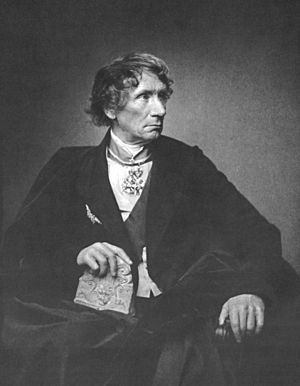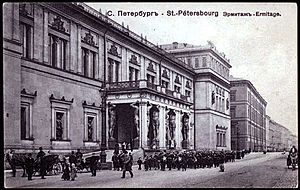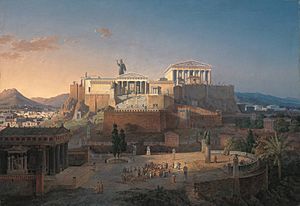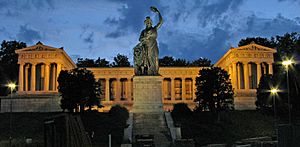Leo von Klenze facts for kids
Quick facts for kids
Leo von Klenze
|
|
|---|---|
 |
|
| Born |
Franz Karl Leopold von Klenze
29 February 1784 Schladen, Germany
|
| Died | 26 January 1864 (aged 79) Munich, Germany
|
| Resting place | Alter Südfriedhof, Munich, Germany |
| Occupation |
|


Leo von Klenze (born Franz Karl Leopold von Klenze; February 29, 1784 – January 26, 1864) was a famous German architect and painter. He was the main architect for King Ludwig I of Bavaria.
Von Klenze loved the Neoclassical style. This style brought back ideas from ancient Greece and Rome. He was one of the most important people who used the Greek revival style in his buildings.
Contents
Biography
Early Life and Training
Leo von Klenze studied architecture in Berlin. He learned from a famous teacher named Friedrich Gilly. Later, he worked in Paris with other well-known architects.
From 1808 to 1813, he was the official architect for Jérôme Bonaparte. Jérôme was the King of Westphalia at the time.
Working for King Ludwig I
Von Klenze later moved to Bavaria. In 1816, he became the court architect for King Ludwig I. This was a very important job.
King Ludwig I loved ancient Greek culture, which is called Hellenism. This love for Greece greatly influenced von Klenze's building designs. He built many buildings in Munich that looked like ancient Greek or Roman structures.
Famous Buildings in Munich
Von Klenze designed many famous buildings in Munich. These include the Ruhmeshalle, which is a hall of fame. He also designed the Monopteros temple in the English Garden.
He planned the whole layout of Königsplatz. This is a large square in Munich that also uses the Neoclassical style. Near Regensburg, he built the Walhalla temple. This temple was named after Valhalla, a famous place in Norse mythology.
Designing Museums
Von Klenze was also very good at designing museum spaces. He created the Glyptothek in Munich. This museum was built for King Ludwig I's collection of ancient sculptures.
He also designed the Alte Pinakothek. This was a large art gallery for the paintings collected by the Wittelsbach family. It opened in 1836. The Alte Pinakothek was built in an open park area called the Kunstareal. It became a national art gallery. People admired how modern and well-planned the Alte Pinakothek was. It was seen as one of the most advanced museum buildings in Europe.
International Recognition
Because of his great work, von Klenze was invited to London in 1836. He was asked about Bavaria's cultural plans and the Alte Pinakothek. Von Klenze explained that the Munich museums were free for everyone to visit. He talked about how they helped educate people.
Work in Greece and Russia
When Greece became independent, King Ludwig I's son, Otto, became its first king. Von Klenze was asked to go to Athens. He drew plans for how to rebuild the city to look like Ancient Greece.
In 1838, Emperor Nicholas I of Russia asked von Klenze to design a building for the Hermitage Museum in Saint Petersburg. This museum was meant to show off a huge collection of art and historical items.
Artist and Collector
Besides being an architect, von Klenze was also a talented painter. Many of his paintings showed ancient buildings. These paintings sometimes helped him plan his own architectural projects. He studied ancient buildings during his trips to Italy and Greece. He even helped with digging up ancient sites in Athens. He also suggested ways to restore the Acropolis.
Von Klenze collected paintings by important German artists of his time. In 1841, he sold his collection to King Ludwig I. These paintings became the start of the Neue Pinakothek museum's collection.
Personal Life and Death
Leo von Klenze married Maria Felicitas Blangini. He passed away in 1864. He was buried in the Alter Südfriedhof cemetery in Munich.
Paintings
- Landscape with the Castle of Massa di Carrara, 1827
- Reconstruction of the Acropolis and Areopagus in Athens, 1846
- Der Camposanto in Pisa
- Landschaft auf Capri
- Der Kreuzgang von San Giovanni in Laterano in Rom
- Der Palazzo Rufolo in Ravello
- Porto Venere on the Gulf of La Spezia
- Reconstructed view of Athens
- Der Domplatz in Amalfi
- Panorama of Tivoli from a Loggia
Architectural works
- In Munich (München):
- Glyptothek (1816–1830)
- Alte Pinakothek (1826–1836)
- Residenz – Königsbau, Festsaalbau and the Allerheiligen-Hofkirche (1826–1842)
- Monopteros temple in Englischer Garten (1836)
- Propyläen Gate (1846–1862)
- Ruhmeshalle (1850)
- Monopteros in the park of Nymphenburg Palace
- Ludwigstrasse, Odeonsplatz and adjacent Wittelsbacherplatz
- Herzog-Max-Palais (1828–1831)
- Ballhouse in Wilhelmshöhe castle park, (Kassel) (1809–1810)
- Ismaning castle (1816)
- Walhalla temple near Regensburg (1816–1842)
- Neues Schloss (New Palace) at Pappenheim (1819–1820)
- New Hermitage in Saint Petersburg, Russia (1839–1852)
- Catholic church of St. Dionysios the Areopagite in Athens, Greece (1853–1865)
- Befreiungshalle in Kelheim (1863)
See also
 In Spanish: Leo von Klenze para niños
In Spanish: Leo von Klenze para niños
- Neoclassical architecture



